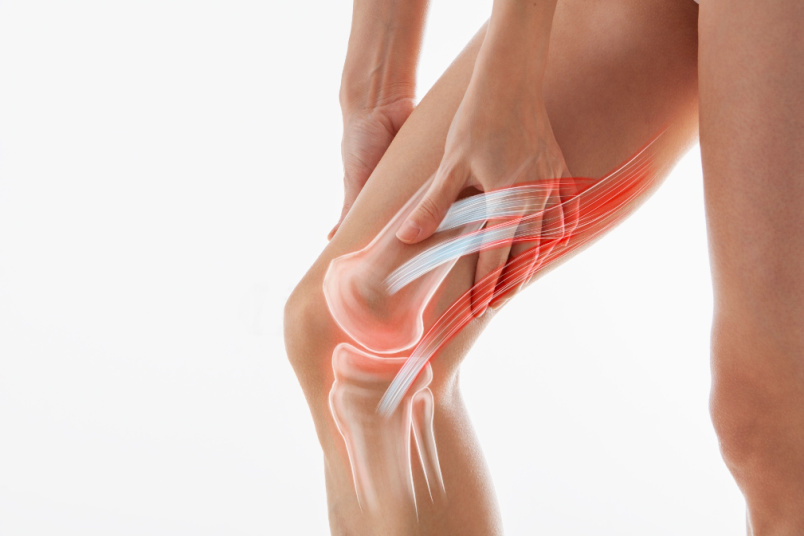Pain can be very debilitating, especially if it restricts your body movements. Having knee or joint pain can be extremely bothersome, particularly if you are suffering from arthritis. Knee and joint pain can be treated at home by taking enough rest and using over-the-counter medications. It is only when the pain interferes with normal activities and continues for a couple of days in a row, that one should consult a healthcare provider.
What is knee pain?

Any pain or discomfort that you experience in and around the knee joint qualifies as knee pain. Joints are places where bones are connected to each other. The knee joint is the place where the thigh bone (femur) meets the shin bone (tibia). The knee joint is the largest joint in the body and bears the whole weight of the body. Knee pain can be temporary, short-term, or chronic (long-term) in nature. You might experience pain:
· Close to the surface, above, or behind the knees
· Deep inside the knees
· In multiple areas of the knees and legs
Common causes of knee or joint pain
The three most common causes of knee pain include:
1. Overuse: Strenuous physical activities such as exercise, playing sports, and doing physical work can cause wear and tear of the knee joint. The pain gets worse when we do the same repetitive motion like working on your hands and knees and jumping a lot. Conditions arising due to overuse:
· Bursitis
· Osgood-Schlatter disease (jumper’s knee)
· Patellofemoral pain (runner’s knee)
· Tendinitis
2. Arthritis: Arthritis results in pain and inflammation of the joints. Knee arthritis is a common occurrence. The symptoms related to knee arthritis are swelling, pain, and stiffness. Several forms of arthritis that can cause knee pain include:
· Osteoarthritis
· Rheumatoid arthritis
· Post-traumatic arthritis
3. Injuries: Any injury to the knee joint can cause pain. Some common knee injuries could be related to:
· Sports injuries
· Repetitive strain injuries
· Traumas such as falls or car accidents
Knee pain may also be caused due to injuries that arise due to knee sprains, hyperextended knees, knee ligament tears, meniscus tears, bone fractures, and dislocations.
Knee and joint pain treatments
Depending on the cause and severity of pain, a treatment plan may be charted by your healthcare provider.
A. RICE method for knee pain- This is a home-based treatment method which stands for rest, ice, compression, and elevation.
(i) Rest: Discontinue the physical activity that has caused the knee pain in the first place so as to avoid making the injury worse.
(ii) Ice: On the first day after the injury, apply ice pack or use a cold compress for 15 to 20 minutes every hour. After one day, apply ice every 3-4 hours. However, care should be taken not to apply ice directly but to wrap it in a towel or washcloth first.
(iii) Compression: Compression lessens swelling and blood flow to your injured knee. Wrap a compression bandage around your knee.
(iv) Elevation: Prop your knees using a pillow or cushion to bring it above the level of your heart.
B. Medications: Over-the-counter non-steroidal anti-inflammatory drugs (NSAIDs) may be helpful to alleviate knee pain and other associated symptoms. A word of caution here–
do not take these medications for more than 10 days without consulting your healthcare provider or if you suffer from kidney or liver disease.
C. Knee braces: Your knee is held in place and supported by a knee brace. Knee braces function by maintaining the alignment of your knee. Usually composed of metal or stiff plastic, they have straps that go around your leg and knee. Consult your healthcare provider regarding the type of brace you will need and how often you should wear it.
D. Physical therapy: Physical therapy is helpful if you are suffering from arthritis or are recovering from a knee injury. Your therapist will teach you stretches and exercises that will strengthen the muscles around your affected knee. This helps in bringing relief in pain.
E. Knee surgery: A knee surgery is generally required if you are suffering from severe arthritis, a damaged ligament, or bone fracture. When no other treatment options work and the pain is severe, a surgery is called for. Knee arthroscopy is the most common form of knee surgery where a special tool called an arthroscope is inserted into the knee joint, after making a few incisions. The arthroscope comes with a fitted camera and light that allows the surgeon to see and repair the damaged knee.
Sometimes, you may need to undergo a knee replacement (arthroplasty) which means that the surgeon replaces the knee joint with an artificial implant (prosthesis). A knee replacement is suggested in case the pain in the knee affects your ability to stand, walk, and move.
Prevention of knee pain
Although neither injuries can be completely avoided nor can arthritis be prevented, yet some measures can be taken to mitigate these from occurring. The ideal way to prevent pain is to stay safe while being active. Ensure that you do the following while engaging in sports and other physical activities:
· Wear the right protective gear.
· Give your body time to rest and recover after intense physical activity.
· Warm up or stretch before playing sports or exercising.
· Cool down and stretch after each physical activity.
For reducing the risk of injuries due to falls, practice the following safety tips:
· Make your home and workplace clutter-free to reduce the chances of trips and falls.
· Use proper tools to reach for things. Do not stand on chairs, tables, and countertops.
· Support yourself with a cane or walker if you have difficulty walking or are more prone to falls.
Everyone suffers from knee and joint pain at some point of time in their lives. While diseases such as arthritis cannot be prevented, you can reduce the risk of falls and trips by following the above guidelines. Ensuring safety both at home and in the workplace will keep you away from injuries that lead to knee and joint pain. In case you do inflict some injury upon your knees or there is pain due to arthritis, consult your healthcare provider on the treatment options available for you.
KM NU Hospitals at Ambur is one of the top multispecialty hospitals in Tamil Nadu. With a team of passionate and dedicated doctors, this healthcare set up is renowned for its orthopedic treatments. If you or a loved one is looking for a knee replacement treatment, this is the best place to opt for your treatment. Visit KM NU Hospitals without delay and get yourself relieved from knee and joint pain.
References:
1. Knee pain. American Society of Anesthesiologists. https://www.asahq.org/madeforthismoment/pain-management/types-of-pain/knee-pain/.
2. Knee pain. Cleveland Clinic. https://my.clevelandclinic.org/health/symptoms/21207-knee-pain.
3. Knee pain. Mayo Clinic. https://www.mayoclinic.org/diseases-conditions/knee-pain/diagnosis-treatment/drc-20350855.
4. Take control of your knee pain. Harvard Medical School. https://www.health.harvard.edu/pain/take-control-of-your-knee-pain.
5. What is knee pain? VERSUS ARTHRITIS. https://versusarthritis.org/about-arthritis/conditions/knee-pain/.
Author: Dr. Tahir Ahmed
